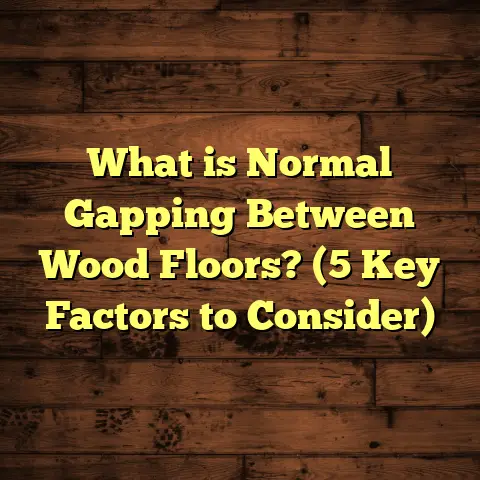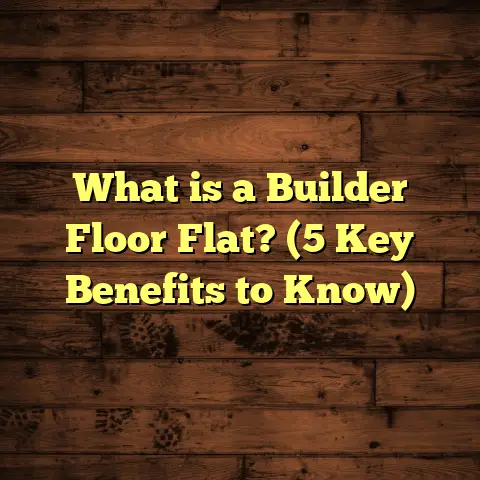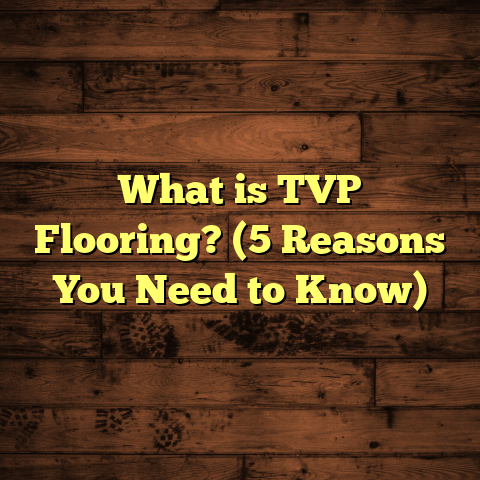What is Wear Layer on Sheet Vinyl Flooring? (5 Key Benefits Explained)
I want to tell you about something that most people don’t think about when choosing their vinyl flooring but which is absolutely critical if you want your floors to last and keep looking good for years. It’s called the wear layer on sheet vinyl flooring. If you haven’t heard of it, don’t worry — I’ll explain everything from what it is to why it’s such a game changer for your floors. Plus, I’ll share stories from my years working as a flooring contractor that might just change how you think about vinyl flooring forever.
What is the Wear Layer on Sheet Vinyl Flooring?
Let me start by breaking down exactly what the wear layer is. Imagine your sheet vinyl floor as a multi-layered cake. At the bottom, you have the backing layer which stabilizes the whole thing and keeps it secure on your subfloor. Next comes the printed design layer—the one that gives your flooring that beautiful wood grain, stone pattern, or whatever look you chose. But here’s the kicker: on top of all that sits the wear layer—a transparent protective coating.
This wear layer acts like an invisible shield between your feet and the pretty design underneath. It’s usually made from a clear vinyl or urethane material that’s tough enough to resist scratches, stains, and scuffs. Without this wear layer, your floor would be extremely vulnerable. Imagine walking on glass with no protective coating; every scratch or spill would mark it permanently.
Thickness Matters: What Does It Mean?
The thickness of this wear layer is measured in “mils,” where one mil equals 0.001 inches. Residential sheet vinyl wear layers typically range between 6 mils and 20 mils, while commercial-grade floors can have wear layers as thick as 40 mils or more.
Here’s what these numbers mean practically:
- A 6 mil wear layer is thin—good for low traffic areas like bedrooms.
- A 12-20 mil wear layer is much thicker and suited for kitchens, hallways, or living rooms.
- Commercial floors use even thicker wear layers to stand up to heavy foot traffic day in and day out.
In my experience installing floors for clients, I’ve seen that this thickness is the single biggest factor in how long a vinyl floor lasts and how well it maintains its appearance.
What Makes Up the Wear Layer?
The wear layer may contain special additives for extra protection:
- Urethane coatings: These create a tough, durable finish that resists scratches and stains better.
- Ceramic beads: Tiny ceramic particles embedded in the wear layer improve scratch resistance.
- UV inhibitors: These help prevent the floor from fading under sunlight exposure.
Different brands and products use a mix of these technologies to create flooring that can handle specific challenges like pets, heavy furniture, or kids running around.
1. Durability Against Daily Wear and Tear
If you’ve ever walked into a home with worn-out floors, you know how quickly scratches and scuffs can ruin a room’s look. From my years working in flooring installation and repair, I can tell you durability is the number one reason to pay attention to the wear layer.
Why Does Thickness Affect Durability?
The thicker the wear layer, the longer it takes for scratches and dents to reach the printed design below. For example, with a 6 mil wear layer, even regular foot traffic over just a couple of years can start showing visible damage. But with 20 mil or more, the floor can withstand heavy traffic for many years without losing its visual appeal.
One of my favorite case studies comes from an elderly couple who had sheet vinyl flooring installed in their home 10 years ago. The kitchen had a 20 mil wear layer floor, while their guest bedroom had only 6 mil. When I did a checkup on the floors recently, the kitchen floor looked nearly new, while the guest bedroom showed obvious signs of wear and tear.
How Much Longer Does It Last?
Data from manufacturers and independent tests show that floors with a 12-20 mil wear layer last approximately 2-3 times longer than those with thinner layers under similar conditions. This means less money spent on repairs or early replacements.
What Happens When Floors Are Thin?
Thin wear layers don’t just show scratches earlier—they tend to degrade faster because they have less material absorbing impact. Over time, this leads to peeling edges, cracking, or fading.
My Advice: If you want your floors to last more than five years without problems—and avoid costly repairs down the road—invest in at least a 12 mil wear layer for residential use. Commercial spaces should go thicker.
2. Stain and Spill Resistance
Vinyl flooring is often chosen for kitchens and bathrooms because it handles moisture better than wood or laminate. But stains can still be an issue if your floor’s protective wear layer isn’t up to scratch.
How Does the Wear Layer Protect Against Stains?
The wear layer prevents liquids from penetrating the surface by acting as a waterproof barrier. When you spill wine or coffee on vinyl with a solid wear layer, it beads up rather than soaking in. This makes clean-up quick and prevents stubborn stains.
In one restaurant project I worked on, the kitchen staff spilled oil frequently during busy hours. The floor had an advanced urethane-coated wear layer featuring ceramic beads. After months of heavy use, not a single stain was visible.
Scientific Backing
Tests reveal floors with urethane-enhanced wear layers resist stains up to 50% better than those with standard vinyl surfaces without added protection.
What About Harsh Chemicals?
If you use common household cleaners or accidentally drop bleach or harsh detergent, a strong wear layer will protect your floor from discoloration or damage.
Tip: Avoid abrasive cleaners regardless of your floor’s wear layer because they can dull even the toughest surfaces over time.
3. Scratch and Abrasion Protection
One of the most common complaints I hear from homeowners is about scratches appearing soon after installation—especially from pets’ claws or moving furniture.
How Does the Wear Layer Help?
A high-quality wear layer acts as a sacrificial shield—it takes the brunt of scratches and abrasions so that the decorative printed layer beneath stays intact.
On one job at an office space with rolling chairs and heavy foot traffic, I recommended sheet vinyl with a 16 mil ceramic bead-enhanced wear layer. After six months, there were hardly any visible scratches even though chairs were moving constantly.
Quantifying Scratch Resistance
Lab testing shows ceramic bead wear layers reduce surface scratches by 60% compared to standard wear layers without ceramic reinforcement.
My Experience With Pets
Pet owners often ask what flooring holds up best against claw marks. Based on projects I’ve done for dog owners, choosing vinyl with at least a 12 mil wear layer plus ceramic beads provides excellent resistance to scratches from claws.
If you’re worried about pets scratching your floors but don’t want to give up on style or comfort, look specifically for these advanced coatings when buying sheet vinyl.
4. Ease of Cleaning and Maintenance
One of my favorite things about sheet vinyl flooring with a strong wear layer is how easy it is to keep clean.
Why Is Cleaning Easier?
The smooth surface of the wear layer prevents dirt and grime from embedding deep into the floor. This means you can usually just mop or wipe away spills without scrubbing hard or using strong chemicals.
Floors with urethane-based wear layers maintain their finish longer because they resist buildup from dirt and oils better than untreated surfaces.
Real-World Example
A client of mine who owns a daycare center chose sheet vinyl with a 20 mil urethane-coated wear layer. She told me she spends less than 15 minutes each day cleaning all her floors combined because they wipe clean so easily—even after paint spills!
Tips for Maintenance
- Use microfiber mops instead of abrasive brushes.
- Place mats at entrances to reduce dirt tracked inside.
- Use felt pads under furniture legs to protect against scratching during cleaning.
- Avoid waxes or polishes not designed for vinyl—they can build up over time and dull your floor.
5. Enhanced Aesthetics and Longevity
The last benefit—and one I think many people overlook—is how much the wear layer protects your floor’s appearance over time.
How It Protects Color and Design
UV rays from sunlight can fade many flooring materials over time. The right wear layers include UV inhibitors that slow down this fading process significantly.
A family I worked with had large south-facing windows in their living room where they placed sheet vinyl floors with UV-resistant wear layers. Even after five years of daily sunlight exposure, their gorgeous wood grain pattern stayed vibrant with no color loss.
Longevity Data
UV-protected wear layers extend visual life by up to 70% compared to unprotected ones according to manufacturers’ durability studies.
Keeping That New Floor Shine
Thicker urethane coatings also keep your vinyl looking glossy longer without needing refinishing or buffing.
Additional Insights: My Personal Stories With Wear Layers
I remember one job where I installed two adjacent rooms with different grades of sheet vinyl—one had an 8 mil wear layer while the other was 18 mils thick. Just two years later during routine cleaning visits:
- The thinner one showed multiple scratches, scuffs, and dulling.
- The thicker one looked almost untouched despite similar foot traffic.
Seeing this firsthand convinced me beyond doubt how important investing in a quality wear layer really is.
Another time, I helped a client replace their worn-out floor after only three years due to low-grade vinyl wearing through quickly under pets’ nails. We upgraded them to 20 mil thick vinyl with ceramic beads this time—and they still rave about how much better it holds up four years later.
Choosing the Right Wear Layer for Your Needs
When helping customers pick flooring options, I always recommend considering:
| Area Type | Recommended Wear Layer Thickness |
|---|---|
| Bedrooms/low traffic | 6-12 mil |
| Kitchens/hallways | 12-20 mil |
| Commercial/retail | 20+ mil |
| Pets/families | At least 12 mil + ceramic beads |
| Bathrooms | Urethane-coated + stain-resistant |
Also check if the product includes UV protection if your rooms get lots of sunlight exposure.
Can You Repair or Replace a Damaged Wear Layer?
A common question clients ask me: What if my vinyl floor’s wear layer gets scratched or gouged—can you fix just that top layer without replacing everything?
The short answer: no. The wear layer is fused into the vinyl during manufacturing; once damaged deeply, it can’t be repaired fully at home or by most pros.
You might be able to buff out minor scuffs temporarily using specialized polishes designed for vinyl floors—but serious damage usually requires replacing the whole sheet vinyl.
This underlines why choosing quality upfront saves money later: avoid cheap floors that look good initially but fail quickly because of thin or poor-quality wear layers.
How Does Wear Layer Impact Cost?
I often get asked about pricing differences related to wear layers:
- Floors with thin (6 mil) wear layers generally cost less upfront but may need replacement sooner.
- Medium thickness options (12-20 mil) cost more but offer better value by lasting longer.
- Commercial-grade thick layers (20+ mil) come at premium prices reflecting their durability but pay off in high-use areas.
Based on dozens of projects and estimates using tools like FloorTally:
- Increasing your wear layer thickness from 6 mil to 20 mil might increase material costs by roughly 20%-40%.
- But you’ll save thousands in repair/replacement costs over a typical 10-year timeline for residential use.
Final Thoughts: Why You Should Care About Wear Layers
If you’re thinking about new flooring or replacing old vinyl, understanding what the wear layer does can help you avoid regrets later on.
From what I’ve seen in hundreds of installations:
- Spending extra dollars on thicker, well-made wear layers
- Choosing ones with ceramic beads and urethane coatings
- Looking for UV protection for sun-exposed rooms
These choices guarantee your floor stays beautiful longer and handles daily life without wearing out prematurely.
Your floor isn’t just decoration—it’s part of your home’s comfort and safety. The wear layer protects that investment quietly but effectively every day beneath your feet.
If you want help estimating costs based on local labor rates or selecting products tailored to your lifestyle (kids? pets? heavy kitchen use?), tools like FloorTally are fantastic resources I recommend using alongside professional advice.
Feel free to reach out if you want personalized recommendations or help comparing options—I’m happy to share what I’ve learned over years in this business!
If you want me to help you further break down any part or want advice specific to your project details like room size or usage patterns, just ask!





